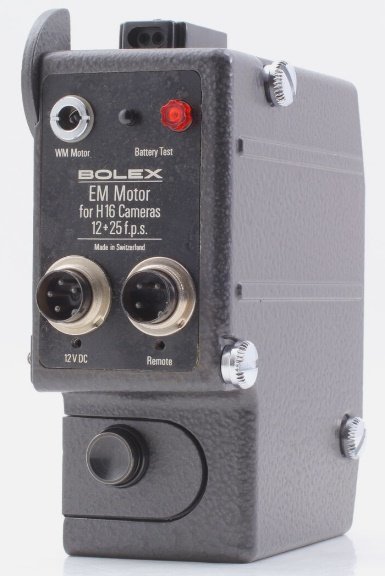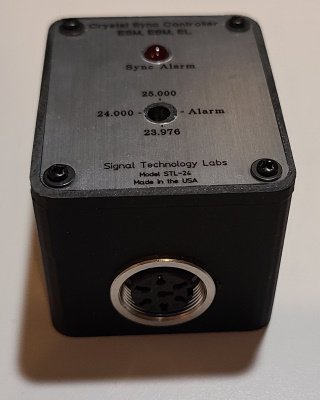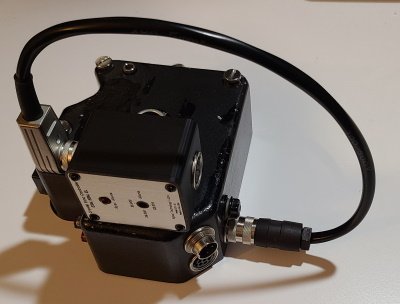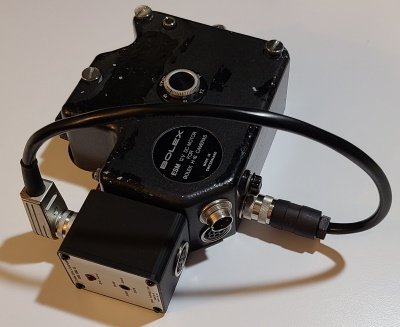
Jason Thompson
Basic Member-
Posts
18 -
Joined
-
Last visited
Profile Information
-
Occupation
Other
-
Location
Roanoke, VA, USA
Recent Profile Visitors
890 profile views
-
Du-all has ESM motors listed on their website for $595. The self-contained Tobin crystal motors (TXM-10, TXM-20, and TXM-26) sell for ~$1000 if you can even find one. They were originally $600 (in the 2000s?). Unless you want to use 8:1 shaft cameras, the ESM + STL-24 approach is certainly more available than the Tobin self-contained crystal motors, which are the true unicorns.
-
We made a complete product. It's a crystal sync controller. There are many people with ELs and EBMs looking for them. Right now, we don't have any interest in the mechanical design work necessary to produce a self-contained sync motor like the Tobin TXM-26 (for 8:1 shafts). My father and I did this for fun - not to make tons of money. He's retired, and I have full-time software engineering employment.
-
WTB: Tobin Crystal Sync Motor for Bolex H16
Jason Thompson replied to Arash Tohidi's topic in Cine Marketplace
The STL-24 is a crystal sync controller - not a motor. It controls the crystal sync capability in the Bolex EL and EBM cameras and the Bolex ESM motor.You could use the STL-24 with a Bolex ESM motor on your RX4, as the RX4 has a 1:1 shaft. -
This project was a collaboration with @Clive Tobin and @Robert Ditto. Clive graciously shared some information to make the project easier. All three of us think it's important to keep the price reasonable and to get units into the hands of actual users (rather than resellers). I sell them for $300 like Clive did when he sold them directly. Price includes USPS Priority shipping in the continental US. Our twist on his TXM-24 design uses modern components, making it smaller and even more reliable. Most of the Tobin TXM-24 PDF instructions still apply. It supports the 23.976, 24, and 25 framerates in one package. Speed adjustment occurs through a small hole to prevent you from changing it accidentally. The Alarm setting tries to sync near zero, which is impossible for Bolex electronics and triggers the Sync Alarm. The STL-24 uses a temperature compensated crystal oscillator (TCXO) that remains consistent between -30C (-22F) and 75C (158F). Its frequency stability is ~2.5ppm, eliminating the need for calibration. The STL-24 includes ESD protection to prevent damage to the sensitive electronics on its circuit board. After posting this demo video on YouTube, I created another form factor with a female 7-pin Amphenol-Tuchel port on the top instead of a permanently attached cable. Customers from the European Bolex community requested this because it supports many cable options and simplifies repair if the cable gets damaged. The top port always connects to the Bolex camera or motor to keep sync (and typically draws power). An EBM requires power to be connected to the STL-24's bottom port. The STL-24's top port connects to the EBM's single 7-pin port. Power passes through the STL-24 to the EBM. The ESM supports this approach too even though it has two 7-pin ports instead of one. Do not connect power to the STL-24's bottom port when using an EL. I am willing to make units with a permanently attached cable until I run out of enclosures. Regardless of form factor, the price is $300 USD shipped in the continental US. If you need a cable, I can make one. The cost varies depending on length and straight/right-angle connectors. As of late 2022, you're looking at $30-45 USD. The original Bolex cables work too.
-
WTB: Tobin Crystal Sync Motor for Bolex H16
Jason Thompson replied to Arash Tohidi's topic in Cine Marketplace
Maybe. I ordered an MCE17B on eBay for $27 USD that is untested and looks rough. We can take it apart to explore what might be required. If we're uninterested in the work, my brother in LA can use it for parts. -
WTB: Tobin Crystal Sync Motor for Bolex H16
Jason Thompson replied to Arash Tohidi's topic in Cine Marketplace
Good point. I forgot to mention the ESM motors only work with the 1:1 shafts on M4, H16S4, RX4 and later. If OP has an 8:1 shaft Bolex, the ESM won't work. -
WTB: Tobin Crystal Sync Motor for Bolex H16
Jason Thompson replied to Arash Tohidi's topic in Cine Marketplace
I know it's past your July timeframe for the specific need. If you are still interested, I make crystal sync units compatible with the Bolex EL/EBM cameras and ESM motor, which all have sync support built-in. You'd need to find an ESM motor. I posted a demo on YouTube a few months ago. My main sales avenue has been Facebook so far. -
Assuming you have 14.4V output from the V-mount, the regulator cable looks like it will work.
-
Roughly a year ago, my brother and I reverse-engineered wiring for his Bolex 12V motors and cameras. I'm posting the details here as a reference We reverse-engineered replica PowerGrip batteries with 10 x 4/5A 2100mAh Ni-MH cells and 2" outside diameter NuTone 3808 central vacuum pipe. In my opinion, it's better to plug a cable into a 12V Li-On battery pack (like JuiceBox) or a battery belt. ??♂️ MST (6-pin) Requires a 6-pin female Tuchel connector (Amphenol T 3401 XXX). Pins 4/5 are ground. Pins 1/2 are +12V. I recommend putting a switch in-line to control on/off. For the in-line switch to work, you will need to bypass the front MST button by putting a jumper between the two remote pins on the back of the motor. MST (7-pin) Requires a 7-pin female Tuchel connector (Amphenol T 3476 XXX). Pin 2 is ground. Pin 5 is +12V. I recommend putting a switch in-line to control on/off. For the in-line switch to work, you will need to bypass the front MST button by putting a jumper between the remote two pins on the back of the motor. In theory, you can bypass the front MST switch without using a jumper by using pin 3 for ground; however, the MST circuitry was not designed for this path to carry that kind of current. It will eventually burn a trace off the circuit board inside, causing smoke to pour from the motor. We know this from experience (and fixed the traces on two MSTs with wire). PowerGrip Requires a 7-pin male Tuchel connector (Amphenol T 3475 XXX). Pin 2 is ground. Pin 3 is +12V. If you are connecting the other end of your cable to a 4-pin XLR 12V power source, please ensure there is no battery inside the PowerGrip when you connect! If I recall correctly, you can connect the other end of your cable to Ni-Cd/Ni-MH battery charger output to charge a battery in your PowerGrip. ESM (3-pin) Requires a 3-pin female Tuchel connector (Amphenol T 3261 XXX). Pin 1 is ground. Pin 3 is +12V. I recommend putting a switch in-line to control on/off; otherwise, the ESM always runs when connected to power by this method. The 3-pin circuitry bypasses the ESM front on/off button. ESM/EBM (7-pin) Requires a 7-pin male Tuchel connector (Amphenol T 3475 XXX). Pin 4 is ground. Pin 3 is +12V. I recommend putting a switch in-line to control on/off; otherwise, the EBM will always run when connected to power. You can control the ESM with the front on/off button although it may be more convenient to use an in-line switch instead. My brother made a quick demo of his EBM using a 4-pin XLR power cable with in-line switch on Vimeo. I hope that helps! For now, I sell these cables (except for the ESM 3-pin) for those not interested in making them.













